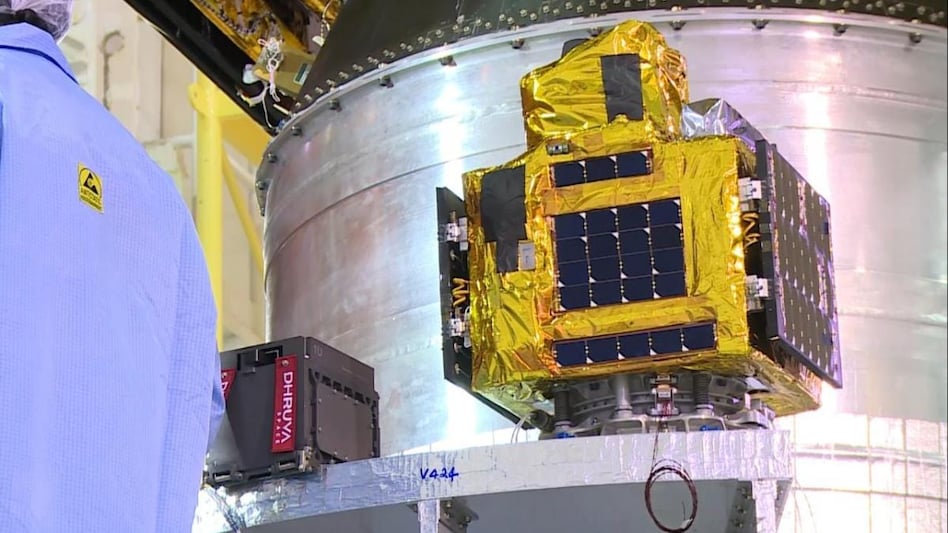 The Saturday launch will help demonstrate and qualify Dhruva Space’s indigenously-developed 0.5U CubeSat nanosatellites
The Saturday launch will help demonstrate and qualify Dhruva Space’s indigenously-developed 0.5U CubeSat nanosatellites  The Saturday launch will help demonstrate and qualify Dhruva Space’s indigenously-developed 0.5U CubeSat nanosatellites
The Saturday launch will help demonstrate and qualify Dhruva Space’s indigenously-developed 0.5U CubeSat nanosatellites Following the successful liftoff of India’s first privately built Vikram-S rocket on November 18, the ambitions of several other spacetech start-ups have also soared. These companies that are developing everything from launch vehicles (rockets) to satellites to space applications, see the Kondapur (Telengana)-based Skyroot Aerospace’s achievement putting their sector on a high growth trajectory.
For instance, within a week of the Skyroot launch, spacetech start-ups Pixxel and Dhruva Space will be sending their payloads on the space agency Indian Space Research Organisation (ISRO) workhorse, the Polar Satellite Launch Vehicle (PSLV), at 1156 IST on Saturday.
The former managing director of one of the country’s leading automakers Mahindra & Mahindra and current chairperson of the single window nodal agency for promoting and regulating space-tech players, IN-SPACe, Dr. Pawan Goenka is thoroughly convinced of the tremendous growth potential of the country’s spacetech sector.
“This maiden rocket launch by Skyroot is perhaps the most important milestone for the Indian private space sector since the space reforms announced by India and hints at the rapid transformative journey, we are witnessing," he said.
However, the pace was perhaps set on June 30 itself when high-end technology payloads of Bengaluru-based Digantara Aerospace and Hyderabad-based Dhruva Space were successfully launched from the iconic Satish Dhawan Space Centre (SDSC) in Andhra Pradesh on July 1.
In an earlier interview with Business Today, Dr. Goenka had accurately forecasted a surge in demonstrable successes by startups in the segment towards the second half of 2022. “And once that happens, a significant amount of investment will also start coming in,” he had observed.
Founder & CEO of small hyperspectral satellite maker Pixxel, Awais Ahmed, felt the country’s spacetech sector had witnessed substantial growth in the last three years. Earlier this year, the Bengaluru-based Pixxel sent a satellite into space using Elon Musk promoted SpaceX's Falcon 9 rocket.
“We have been rooting for Skyroot ever since we got started in our space journey. We eagerly look forward to someday launching our satellites with them as well,” remarked Ahmed.
Pixxel will be putting its third earth imaging satellite Anand (meaning joy) in space, while Dhruva Space will be launching its Thybolt series of communication satellites.
“In June we had successfully space-qualified our orbital satellite deployer onboard PSLV. The Saturday launch will help demonstrate and qualify our indigenously-developed 0.5U CubeSat nanosatellites, Thybolt-1 and Thybolt-2,” said the head of the strategy & special projects at Dhruva Space, Kranthi Chand.
Aimed at amateur radio or ham users, the Thybolt mission is supported by several notable radio clubs across the country, including Star Fleet Amateur Radio Club, National Institute for Amateur Radio (NIAR), Indian Institute of Hams, Aniruddha's Academy of Disaster Management, West Bengal Amateur Radio Club, Indian Academy of Communication and Disaster Management and SSM College of Engineering. India is estimated to have more than 22,000 licensed ham radio operators.
“The potential is huge!”
A faculty member in the Department of Aerospace Engineering at Indian Institute of Technology (IIT)-Madras & co-founder of The ePlane Co., Prof. Satyanarayan R Chakravarthy saw the country emerge as the carrier of the world’s payloads into outer space. Incidentally, Prof. Chakravarthy has successfully incubated several startups, including the Chennai-headquartered AgniKul, which recently test-fired the world’s first single-piece 3D-printed rocket engine, and is now prepping to send its first Agnibaan rocket into space.
“Along with SSLV of ISRO, Skyroot and AgniKul, all put together, we can potentially become the space lorries, if you will, to haul all the baggage for the world,” said Prof. Chakravarthy. “The next thing that is possible is that startups can piggyback on ISRO’s success and double down in taking human beings to at least the Lower Earth Orbit (LEO) for tourism. The potential is huge!”
Digantara Research & Technologies co-founder & CEO, Anirudh Sharma describes 2022 as a “transformational year” for Indian spacetech startups.
“There has been a paradigm shift in the private Indian space ecosystem over the last year. Spacetech start-ups in India have repeatedly showcased their ability to build critical technology independently and the government support to realise the technology has given them the confidence to leap into building products for the world,” remarked Sharma.
Digantara is already building a Space Situational Awareness (SSA) observatory in the hill state of Uttarakhand for tracking satellites and space debris in the LEO and the Geosynchronous Earth Orbit (GEO), to offer global space traffic management operations.
With a significant 36 per cent share, the satellite services and application segment would form the largest share of India's space economy, a joint study released by EY and the Indian Space Association (ISpA) in October has noted.
Elaborating on the report’s projections, the director general of ISpA, Lt. Gen AK Bhatt, said, “India’s space economy is set to grow to $13 billion and the space launch segment is estimated to grow the fastest by 2025 at a CAGR of 13 per cent, which will be further spurred by growing private participation, latest technology adoption and low cost of launch services.”
Moreover, the country’s satellite manufacturing capability is expected to be worth $3.2 billion by 2025 from $2.1 billion in 2020.
Copyright©2025 Living Media India Limited. For reprint rights: Syndications Today